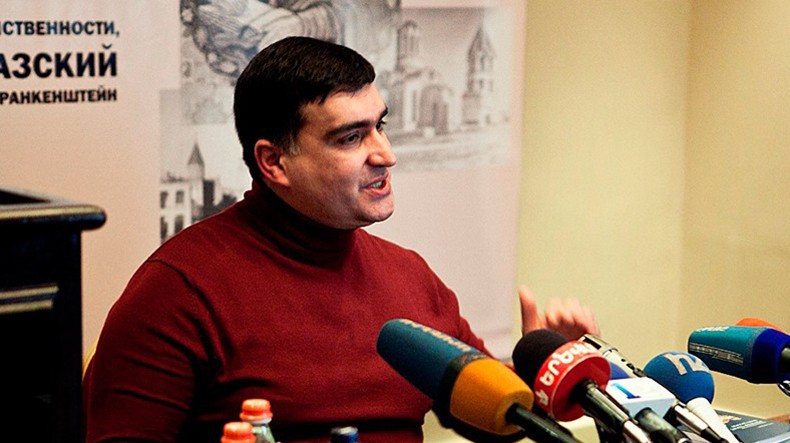
Aris Ghazinyan: Politicians and scientists in Turkey and Azerbaijan completely ignore primary sources on Yerevan history
The speech of the head of the Institute of History of ANAS (Azerbaijan National Academy of Sciences) Yaqub Mahmudov in a ceremony of giving state awards to historians, who “proved” that Yerevan, Nagorno Karabakh, and Nakhijevan “belong to Azerbaijan”, is an evident illustration of the fact that history in Azerbaijan is modeled upon decrees, orders, and program speeches of the president. Ilham Aliyev, the president, himself awarded them. Armenian journalist and researcher Aris Ghazinyan writes about it in the preface of his book “Yerevan: with a cross or on the cross,” which is an attempt of setting and considering an extremely diverse range of processes directly or indirectly forming the character of the development of the territory in question and predetermining the inevitability of turning Yerevan into the main center of the Eastern Armenia, and later on into the capital of the recovered Armenian state.
“For the first time we prepared and published the National Atlas of our Azerbaijan, hoping and relying on you. With the immediate order of Your Excellency, fundamental researches ‘Karabakh: real history, facts, documents’, ‘Nakhchivan: history and monuments’, and ‘History of Irevan khanate’ were written, translated to foreign languages, and distributed in several countries of the world. <…> Today Azerbaijani historians wage an information war against Armenian aggressors in accordance with your appeal, orders, and recommendations. <…> Dear President, the historians, who are your colleagues in the sacred fight for Motherland you wage in this complicated world, will always be by your side. All of us, including the awarded historians, are your soldiers. A wise, courageous, and strong Supreme Commander like you stands behind us,” Ghazinyan cites Yaqub Mahmudov’s statement in his book.
Commenting on Yaqub Mahmudov’s speech, Ghazniyan notes that, being the indicator of the system of academic morals in this republic, it reflects the state of affairs in the Azerbaijani history science. “Is it worth doubting that if, according to Pan-Turkic shadow history concepts, brought to the level of official historiography and propaganda, Sumerians and Elamites, Gutians and Hurrians, Scythians and Cimmerians, and eventually, the Armenians are ‘Turks’, then Yerevan, by definition, cannot be a ‘genuine Azerbaijani city’,” he mocks.
Regarding the thesis about the founding of Yerevan by Safavid military leader Revan-Kuli khan, which is circulated by Azerbaijani historiography, Ghazinyan mentions that it goes back to the Ottoman author of XVII century Evliya Celebi: “… one of the favorites of emir Timur, merchant Hoja Han Lehicani, stepped on the land of that Yerevan. He saw a fertile land and settled here with the members of his family. Day by day, he grew rich with rice cultivation and built that city. Later <…> Ismail, Shah of Iran, ordered his vizier Revan-Kuli khan to build a fortress in that place. The latter built the fortress in seven years and named it Revan.”
“Let us compare this story with the official standpoint of Azerbaijan presented by one of the loud-hailers of state propaganda, erevangala500.com portal: ‘Irevan was founded in the beginning of XVI century as a basic fortress of the Safavid (Turkic-Azerbaijani) Empire on the border with the Ottoman Empire. According to memoirs of famous Turkic traveler Evliya Celebi, in 1510 Shah Ismail I of the Safavid Dynasty ordered to build a fortress on Zenga river in order to stop the advancement of the Ottomans to the East. Vizier Revan-kuli khan was charged with the construction. The name of the fortress Revan-kala comes from here, and it transformed into Irevan over time’,” he writes noting that, meanwhile, the Turkish and Azerbaijani political and scientific circles completely ignore the primary sources, which inform about various incidents of the life of medieval Yerevan, preceding the invasion of Turkic tribes in the region.
In particular, there is nothing about the participation of delegates from Yerevan, priors David and Jajik, in Dvin Council in the beginning of VII century, which is originally mentioned in “The Book of Letters”. The evidence of Sebeos, an author of VII century, about the defeat of the Arab army near Yerevan, remains ‘unnoticed,’ too: “The Ishmaelite troops arrived in Atropatene and were divided into three parts. One detachment went to Ayrarat <…> they came, gathered near Yerevan, fought for capturing the fortress, but failed.” The information of Catholicos Hovhannes Draskhanakerttsi about another battle between Armenians and Arabs near Yerevan in the beginning of VIII century is also ignored: “… after a while, he adopted a martyr’s crown in Dvin. There was a battle near Yerevan at that time; those, who described that war before us, give enough information about its circumstances.”
“There are many such examples of ignoring the original sources,” Ghazinyan writes stating that it becomes more revealing with the fact that the Institute of History of Azerbaijan National Academy of Sciences is named after Abbasgulu Bakikhanov, a famous scientist of the first quarter of XIX century, who describes the migration of the Turkic tribes to the region and literally writes the following: “Qajars are a Jalair Turkic tribe from those two hundred thousand families, who were resettled in Persia by Hulagu Khan (grandson of Genghis Khan) <…> Emir Timur resettled fifty thousand families of those Qajars and settled them in Erivan, Ganja, and Karabakh, where their number increased during time. Many of these Qajars were state officials and governed in Armenia and Shirvan during the ruling of Safavid shahs. Khans of Erivan and Ganja originate from them.”
Modern Azerbaijani scientists, the members of the Institute of History of ANAS, obviously ignore the scientific heritage of the person, after whom the institution is named, summarizes Ghazinyan, citing the head of the Institute of History of ANAS Yaqub Mahmudov as an example: “… forced armenification of the Western Azerbaijan and Irevan khanate, now the Republic of Armenia, and expulsion of native Azerbaijani population started.”
To be continued.
Aris Ghazinyan’s “Yerevan: with a cross or on the cross” is a book about the social and political history of Yerevan and Yerevan district (as a habitat) since the declaration of Christianity to the beginning of XIX century. In addition to demonstrating historical facts based on archive documents and sources, the book also considers the fundamental theses of the Azerbaijani historiography and Pan-Turkic ideology aimed at appropriating the historical, cultural, and spiritual heritage of the Armenians and other nations of the region by falsifying their history.
Related news
- Aris Ghazinyan: Past and future in Azerbaijan are modeled upon decrees and program speeches of president
- ‘Polygon Azerbaijan’: Azerbaijan’s true history ‘in context of global political processes’
Newsfeed
Videos






























